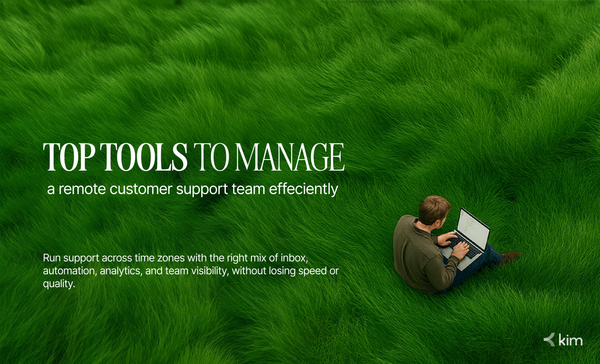Why Every Shopify Store Needs a Virtual Assistant in 2025

Introduction
Running a Shopify store in 2025 isn’t what it used to be. With customer expectations rising, competition getting sharper, and tools evolving faster than ever, simply having a great product isn't enough. Today's successful Shopify merchants are those who operate with precision, agility, and round-the-clock support. But doing that alone—or even with a small team—can quickly become overwhelming.
That’s where a Virtual Assistant (VA) comes in.
Whether it’s managing your product listings, handling customer queries, updating store content, or supporting your marketing initiatives, a skilled Shopify VA can help you streamline operations, reclaim time, and scale faster—without hiring a full in-house team.
In this article, we’ll explore why hiring a Virtual Assistant has become essential for modern Shopify stores, what tasks they can manage, and how the smartest brands are combining human support with tools like Kim.cc to create lean, scalable systems for growth.
- What Tasks Can Virtual Assistants Take Over for Your Shopify Store?
- Why Hiring a VA Is Cost-Effective and Operationally Smart
- Real-World Success Stories: How VAs Helped Brands Scale
- How to Hire and Vet the Right Virtual Assistant for Your Shopify Store
- Tools That Make VA-Driven Support Models Work
- Conclusion: Building a Lean, Scalable Shopify Operation
1. What Tasks Can Virtual Assistants Take Over for Your Shopify Store?
As Shopify stores scale in 2025, so does the complexity of everyday operations. From updating product listings to ensuring every order is fulfilled on time, the to-do list grows faster than most founders can keep up with. This is where virtual assistants (VAs) quietly become the operational backbone of modern eCommerce businesses.
A well-trained VA can take over the repetitive, time-intensive tasks that are critical to your store’s success but don’t necessarily require your personal oversight. By freeing up your bandwidth, they enable you to shift focus from execution to strategy—without compromising on quality or consistency.
Product and Catalog Management
Keeping your product catalog updated, organized, and optimized is non-negotiable. But manually uploading new products, writing SEO-friendly descriptions, and managing variants across collections can quickly turn into a full-time job.
Virtual assistants familiar with Shopify can handle:
- Bulk uploads using product templates
- Creating and updating collections for seasonal or campaign-based drops
- Ensuring all listings include relevant tags, alt text, and meta descriptions
- Archiving out-of-stock or discontinued products
Order Fulfillment and Logistics Coordination
Smooth order fulfillment is a key driver of customer satisfaction. But it also involves dozens of backend steps—many of which don’t require a founder’s input. Virtual assistants help maintain consistency by:
- Monitoring new orders and confirming payment status
- Coordinating with suppliers or fulfillment partners for dispatch and tracking
- Updating customers with order status and resolving failed deliveries
- Handling return logistics and issuing refunds where applicable
Customer Support and Response Management
The expectation of 24/7 availability isn’t just limited to enterprise brands anymore. Even small to mid-sized DTC stores are expected to respond within a few hours across email, chat, and social channels.
A virtual assistant can own this function entirely by:
- Managing customer conversations across channels like Shopify Inbox, Gorgias, or WhatsApp
- Providing order updates, product information, and basic troubleshooting
- Maintaining and updating a help center or FAQ section
- Escalating complex issues to internal teams when required
Several stores pair their VAs with platforms like Kim.cc, which offers a hybrid model of AI + human agents to ensure instant responses at scale. The VA steps in only when AI can’t resolve the query—keeping both costs and wait times low.
Store Maintenance and Content Updates
Shopify themes and third-party apps require regular upkeep. A VA with some technical fluency can:
- Test the store on mobile and desktop to ensure optimal performance
- Flag broken links, slow-loading pages, or UX inconsistencies
- Update pop-ups, banners, and landing page content
- Support app integrations or troubleshoot minor issues
Marketing and Campaign Execution
Execution is often where great marketing strategies fall apart. While you focus on ideation and planning, a VA can take care of:
- Scheduling and sending email campaigns via Klaviyo, Mailchimp, or Omnisend
- Uploading assets like banners, coupon codes, and product shots to Shopify
- Coordinating influencer or affiliate outreach efforts
- Preparing performance reports to evaluate campaign results
Reporting and Performance Tracking
Decision-making in eCommerce is only as good as the data behind it. VAs trained in analytics can help you:
- Pull daily or weekly reports from Shopify, GA4, and Meta Ads Manager
- Summarize KPIs like conversion rates, average order value, or customer lifetime value
- Highlight anomalies, trends, or underperforming SKUs
- Create dashboards or slides to support monthly reviews
2. Why Hiring a VA Is Cost-Effective and Operationally Smart
Hiring in-house talent comes with overhead—recruitment costs, training, payroll, equipment, and benefits. For most Shopify brands, especially lean DTC operations, these costs can quickly outweigh returns if not structured properly.
Virtual assistants offer the flexibility to scale support without locking into fixed expenses. Most work hourly or on retainer, which allows you to ramp tasks up or down based on seasonal demand. This flexibility proves especially valuable during sales periods, launches, or off-seasons.
Moreover, VAs often bring specialized experience. Whether it's someone who’s managed Klaviyo campaigns or updated hundreds of SKUs in bulk, you’re not starting from scratch. The onboarding time is lower—and the learning curve is flatter.
When paired with tools like Kim.cc that help automate lower-tier queries and ticket routing, a single VA can often do the work of multiple agents—creating a compounding return on efficiency.
3. Real-World Success Stories: How VAs Helped Brands Scale
Brands that adopt VA-driven workflows early often outperform those that wait. One DTC skincare label, for instance, outsourced product uploads and email campaign scheduling to a VA, freeing up their core team to focus solely on influencer partnerships and product development. Their repeat purchase rate jumped 20% within a quarter.
Another fashion brand combined one VA with Kim.cc’s AI layer to handle all first-response customer support. Resolution times dropped by 60%, while CSAT improved week over week.
These aren’t anomalies—they reflect what happens when lean teams invest in structured delegation and automation.
4. How to Hire and Vet the Right Virtual Assistant for Your Shopify Store
Finding a great VA starts with clarity. Document your most repetitive or time-sensitive tasks, then look for someone with proven experience in those exact areas.
Use platforms like Upwork, OnlineJobs.ph, or talent networks that specialize in eCommerce VAs. Prioritize:
- Shopify-specific experience
- Familiarity with tools like Klaviyo, Gorgias, Canva, or GA4
- Strong written communication
- Proactivity and response time
Always start with a paid trial task before handing over access. Limit permissions using Shopify’s staff account roles, and consider tools like LastPass to share credentials securely.
5. Tools That Make VA-Driven Support Models Work (Including Kim.cc)
The right tech stack can elevate a VA from a task-taker to an operations engine. At the core, your store should be equipped with:
- Shopify + analytics integrations (GA4, Triple Whale)
- Email marketing (Klaviyo, Mailchimp)
- Helpdesk (Gorgias, Re:amaze)
- Project management (Asana, Notion)
And for customer service, platforms like Kim.cc are changing the game. They blend AI-driven automation with human support in a scalable way. You can use them to resolve high-volume queries instantly, and bring in your VA only when escalation is needed—significantly reducing response times and support costs.
In this hybrid model, a lean team can match the efficiency of much larger operations.
Conclusion: Building a Lean, Scalable Shopify Operation
The eCommerce landscape in 2025 is fast-paced and margin-sensitive. Shopify merchants can’t afford to be bogged down by tasks that don’t directly drive growth.
Hiring a virtual assistant isn't just about delegation—it’s about creating room for strategic thinking, faster experimentation, and better customer experiences. When combined with the right platforms and automation layers like Kim.cc, VAs become a multiplier, not just a support function.
If your Shopify store is growing—or you want it to—building a lean operational core with virtual assistance is no longer optional. It’s foundational.
Want to scale smart? Pair your VA with Kim.cc and handle support like a pro.




